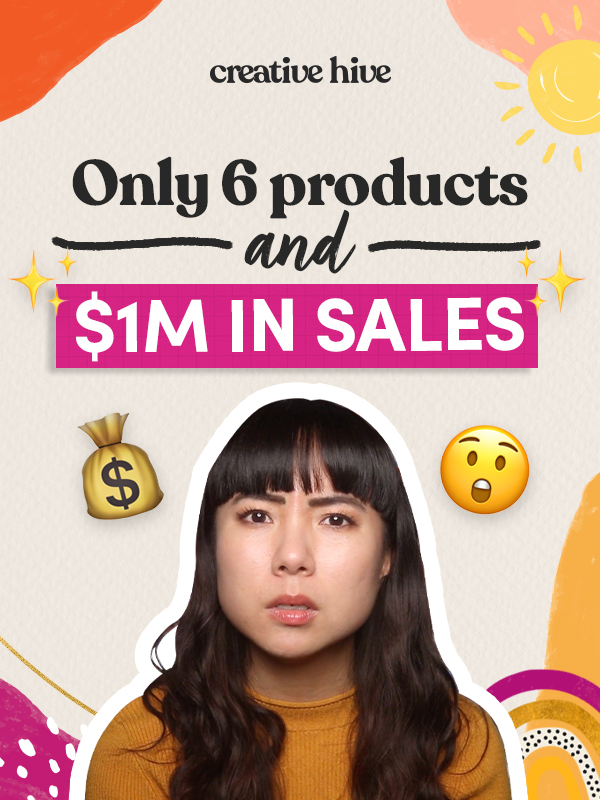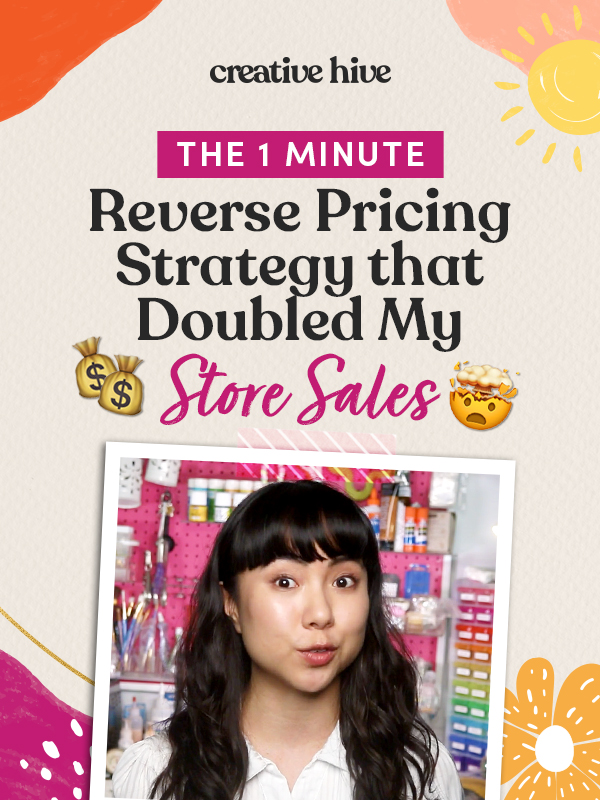I want to help you build a sustainable, profitable handmade business that makes you consistent income and sales. I only ever teach or recommend marketing, social media, pricing, production and branding tips that I’ve personally used successfully in my own 7-figure handmade businesses.
I'm Mei, from Los Angeles!
Read More
Popular Posts You'll Love
Looking for something?
Categories
starting a business
get more traffic
running a business
make more sales
branding
growing a business
mindset & productivity
podcasts
pricing & money
product photography
reviews
selling on etsy
selling on amazon
social media
selling wholesale
- Facebook0
- Twitter1
- Pinterest0
- 1share
You can make more profit in your handmade business if you can get a customer to buy from you again and again.
If you’re having trouble getting them to come back and turn into repeat customers, read this post.
I’m going to share with you 5 easy ways to get more repeat buyers so you can make more sales and more money without it being a lot of extra work for you.
The Cost of Making a Sale
One thing I want you to understand is there’s a cost to make a sale in your shop.
Whether that’s the cost of your time or money that you’ve spent to get in front of your customers. That’s still a cost.
Let’s say it costs $15 on average to get someone to buy from you and they place a $40 order in your shop.
That $15 might be cash you’ve spent on paid ads or the time that you spent posting on social media or talking to a potential customer on the phone, or whatever it is. It’s effort and time you’ve spent that costs money.
The beautiful thing about repeat customers is they cost a lot less to get after they’ve bought from you for the first time.
Instead of that $15 before, now it costs $5 worth of money, time, and effort to get them to come back and spend another $40.
Repeat sales should make up a significant percentage of your business income.
Around 30%-50% of my sales are from repeat customers. That’s a great sign that people love your products.
1. Implement a Loyalty Program
My first tip for you is to implement some sort of loyalty program or points program so your customers have an incentive to buy again.
I’m sure you’re a part of a loyalty or points program yourself. I’m in at least 2 of them that I actively use.
One of them is for 99 Ranch, which is an Asian grocery store near our house. Every time we buy groceries, we get some points and we’ve actually been able to get $10 off our entire bill because of those points.
I’m also a part of the loyalty program at my favorite smoothie place. Every time I buy a smoothie, they put a little stamp on my loyalty card, and when I’ve bought 10 smoothies, I get 1 free smoothie on my next order.
If you decide to put some sort of program like this in your shop, I have a few suggestions for you.
Make the First Order Appealing
Make their first order appealing. Maybe your program is simple where it’s $1 translates into 1 point. Or when you get to 100 points, you get a 10% off coupon code.
To incentivize that first order even more, make it so that your customers get an extra 50 points on top of their order. This will help them feel encouraged to spend more so they can get that reward.
There’s actually a term for this, and it’s called gamification.
It’s like when you’re playing a video game. People love that feeling of accomplishment when they can level up and get some rewards.
Apps You Can Use
There are some cool apps you can use to put this program in place.
If you use Shopify, one app that has a lot of great reviews is Smile Rewards.
What’s great about it is they have a free plan you can start with.
Now, I don’t think every business model works well with loyalty points.
I think you need to have a product people feel like they want to collect. So if you already have that built-in quality where people naturally want to buy your products over and over again, a loyalty program can help increase that repeat customer rate.
For example, if you sell children’s artwork, a loyalty program probably won’t benefit you as much as say someone who sells tea or soap.

2. Get Your Customers on Your Email List
If you’re not using one yet, you really need to get your customers on an email list.
If you do have an email list for your business, figure out how you can segment your email list so that you can send emails to just your previous buyers.
This is a pretty basic and expected feature to have with an email system, so if yours can’t do that, I recommend moving over to one that can. MailerLite is a good free option that can do this.
This is so important to do because a huge percentage of your repeat sales will come from your email list if you do it right.
To take this one step further, you should use autoresponders or automations. These are basically a series of automated emails that get sent to people who’ve purchased from you before.
Set it up so that one month after someone buys from you for the first time, they receive an automated email where you’re talking about another different product in your shop that you think they’ll like.
If they don’t buy then, set up your automation to wait two weeks and then send another email. This time you can include a coupon code to incentive them to buy again.
Most handmade shop owners aren’t doing this and it’s so simple to do.
Once you set it up, you don’t have to do any work. It’s literally set it up and then forget about it. It works for you on autopilot.
Before I move on to my next tip, if you’re enjoying this post, please leave me a comment below. I’d also love to know if you have any tips of your own to share about how you’ve been able to get more repeat sales in your business.
3. Subscription or Recurring Products
If you don’t yet have a subscription product, I highly recommend you start thinking about how you can create one.
I only have one subscription product, my Necklace of the Month Club, and I’ve been running this for the last 6+ years now.
It makes up 50% of my income.
It’s crazy! It’s super effective when you do it right.
Subscription products are super popular these days. You might have heard of Stitch Fix or Bark Box. You get a box every month with a few different things for a monthly fee. It’s an automatic payment like a Netflix subscription.
The nature of subscriptions is it’s usually a surprise for the customer. They don’t know what they’re getting.
I don’t want you to freak out and think that you have to include multiples of your own products in each box to each customer. You can keep things simple.
My Necklace of the Month Club is just one surprise necklace per month. I can’t do any more than that because the pricing just doesn’t work out any other way.
When people join your subscription it’s a good fit, they’ll stay in it for at least a few months.
What I love about subscriptions is it gives you that consistent income which is really nice because we all know how much of a roller coaster running a business can be and with normal one-off sales.

4. Sell a Consumable Product
Your business may already be like this naturally. Maybe you sell:
- soap
- candles
- food
- dog treats
- planners
- stationery
- skincare
- makeup
A consumable product is something that gets used up over time. When your customers run out or use it all up, they’re going to come back and buy from you again.
I like to tell people that if I were to start a new business, I’d seriously think about how I could make a business that’s selling primarily consumables.
But what if your business doesn’t sell consumables?
Like for my jewelry business, even though my charms look like food, they don’t actually get eaten. With that being said, my jewelry is scented and the fragrances do disappear over time.
Something I could do is sell the refills of the fragrance oils to my customers.
But what if you sell art prints?
I don’t think it’s totally crazy to put your art on products that are consumables like notepads, journals, greeting cards, or stickers.
This might be a good reason to make a totally new product collection of consumables, but that still has your art on it. That way everything in your shop is still cohesive and consistent.

5. Give Amazing Customer Service
I’m talking about a level where you go above and beyond. Go the extra 10 miles for your customers.
Especially when something goes wrong with a person’s order.
This was something I learned many years ago.
If you can turn an unhappy customer into a happy customer by giving a really good customer service experience, that customer is going to be much more loyal to you than a customer who just had a normal, positive experience with your shop.
And it makes sense, right?
Making the effort to right a wrong, even if it’s not your customers fault and it costs you more money to fix the problem, shows your customer what kind of shop or brand you are.
That’s the kind of service that people will tell all their friends about.
It’s like you and your customer have been through a difficult situation, and they’re extra appreciative of being taken care of so well.
Don’t Take it Personal
This is going to be hard for a lot of people to do because, as shop owners, we’re so close to our products.
When we do customer service, it’s so easy to be defensive or to take things personally.
I recommend when you do get that email that’s describing some sort of problem from a customer, that you don’t respond to that email right away.
If you do, you’re likely to say something impulsive that might feel good to say in the moment, but you’re going to regret later.
What I suggest instead is to take a step away from your computer and from that email for around an hour. That way when you come back to it, you’re not going to be responding from a position of emotion, but more from a place of objectivity.
That’s how you’re going to be able to do your best at helping your customer with their situation.
Don’t let your ego or pride get in the way. This is not the time where you need to be right.
The customer may not be right and it could totally have been their fault, but be the bigger person and do everything you can to help them.
It’s like karma. Your actions will pay you back over the long term, so it’s totally worthwhile to go that extra mile.
If you’re thinking about like situations where maybe the customer gave you the wrong shipping address and now their package is being returned to you. Offer to ship it back to them again.
I know it’s not your fault and it’s not USPS’s fault. If you’ve priced your products correctly, you can afford to pay for shipping again out of your own pocket and still make a profit from this order.
If you don’t make a profit from this order and you’re just breaking even, think about it as a whole. You’ll make a profit from all your other orders.
These kinds of situations only happen like once every two to three dozen orders. It doesn’t happen often.
I say all of this to encourage you to give the best service to your customers and not come from a place of fear that you’re going to lose out.

Leave a Comment
Liked this article? Share it!
Unlock a Profitable Handmade Business
in Just 12 Weeks Without Using Etsy
or Social Media
FREE WORKSHOP
This workshop is for anyone who makes and sells a handmade or physical product, including jewelry designers, artists, paper designers, bath & body product makers and more!
What You'll Discover
The #1 mistake people make with Etsy & social media that causes shops to FLOP
The secret to making it with your handmade shop so it's no longer just a hobby
How to make sales in your handmade shop with ease so you can finally get to 6-figures
TAKE ME THERE
Your email address will not be published. Required fields are marked *
Leave a Reply Cancel reply
About
Blog
A Sale A Day
Student Login
Free Class
Contact
Terms
Become A Student
Watch On YouTube
Student Reviews
See My Handmade Shop!



Good tips. I would have not stopped to think about the different ways to make any of my products consumable